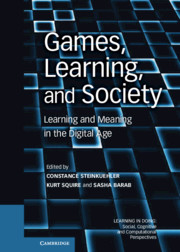Book contents
- Frontmatter
- Contents
- Contributors
- Series Foreword
- Foreword
- Acknowledgments
- Section I Games as Designed Experience
- Section II Games as Emergent Culture
- 10 Introduction to Section II
- 11 Nurturing Affinity Spaces and Game-Based Learning
- 12 Apprenticeship in Massively Multiplayer Online Games
- 13 Theorycrafting
- 14 Culture and Community in a Virtual World for Young Children
- 15 Culture versus Architecture
- 16 Participatory Media Spaces
- Section III Games as Twenty-First-Century Curriculum
- Index
- References
16 - Participatory Media Spaces
A Design Perspective on Learning with Media and Technology in the Twenty-First Century
Published online by Cambridge University Press: 05 August 2012
- Frontmatter
- Contents
- Contributors
- Series Foreword
- Foreword
- Acknowledgments
- Section I Games as Designed Experience
- Section II Games as Emergent Culture
- 10 Introduction to Section II
- 11 Nurturing Affinity Spaces and Game-Based Learning
- 12 Apprenticeship in Massively Multiplayer Online Games
- 13 Theorycrafting
- 14 Culture and Community in a Virtual World for Young Children
- 15 Culture versus Architecture
- 16 Participatory Media Spaces
- Section III Games as Twenty-First-Century Curriculum
- Index
- References
Summary
The learning sciences distinguish itself as a field within education research by their attention to how insights about the cognitive and sociocultural nature of thinking and learning can be applied to the design of learning environments. As a learning scientist, an artist, and a digital media scholar, I am drawn to questions of how to design spaces for young people so that they can participate successfully in media arts–based production activities. I call these participatory media spaces, an extension of Jenkins, Purushotma, Clinton, Weigel, and Robison’s (2007) framing of digital spaces for artistic production and civic engagement as participatory cultures. The rhetorical shift from participatory cultures to participatory media spaces means changing our focus from documenting what happens in these spaces and how people participate to insights about how to design learning environments with specific learning goals in mind. While prior work has focused on what people learn from their engagement in participatory cultures (Gee, 2007; Ito et al., 2010; Jenkins et al., 2007), I consider design from the perspective of intentional learning. There is no doubt that learning happens as a result of engagement in participatory cultures. Learning happens no matter what we do (Wenger, 1998). However, learning something is an entirely different matter. In this chapter I shift the focus from an understanding of learning in participatory media spaces to how to design participatory media spaces so that young people can engage successfully in artistic production processes.
- Type
- Chapter
- Information
- Games, Learning, and SocietyLearning and Meaning in the Digital Age, pp. 244 - 268Publisher: Cambridge University PressPrint publication year: 2012
References
- 12
- Cited by



